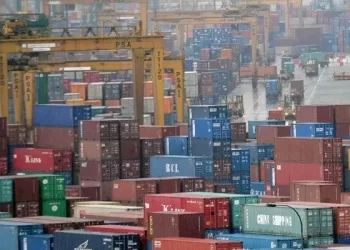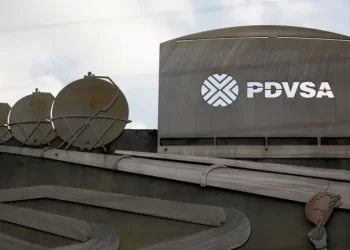ST. JOHNSBURY, Vt. (news agencies) — Thunderstorms and torrential rain brought another wave of violent floods Tuesday that caved in roads, crushed vehicles, pushed homes off their foundations and led to dramatic boat rescues in northern Vermont, nearly three weeks after flooding from Hurricane Beryl.
Flash flood warnings remained in effect through Tuesday afternoon hours after some areas got 6 to more than 8 inches (15 to more than 20 centimeters) starting late the night before.
In Lyndonville, a town about 40 miles (64 kilometers) north of Montpelier, the state capital, Deryck Colburn said he awoke before daybreak to a neighbor pounding on his door. Colburn said he heard the same surge of rushing water from an overflowing brook that he’d heard earlier in July, along with the unnerving sound of tumbling boulders carried by the water.
“I went down the road to her house, and there was no road. There was just a river,” he said.
The fresh flooding yielded similar scenes of catastrophe to the flooding weeks earlier, but on a smaller scale. Cars and trucks were smashed and covered in mud; several homes were destroyed and pushed downstream; utility poles and power lines were knocked down; and asphalt roads yielded to cliffs in spots where roadbeds were carved away.
Most of the rain fell in the Lyndon and Lyndonville areas, and in St. Johnsbury, about 10 miles (16 kilometers) south. Police issued a “shelter in place” advisory Tuesday morning for St. Johnsbury, a town of about 6,000 people. At least 5 inches (12.7 centimeters) of rain fell farther north in area of Morgan, which is near the Canada border.
Mark Bosma, a spokesperson for the Vermont Emergency Management Agency, said swift water rescue teams in boats conducted approximately two dozen rescues in the dark in the hardest-hit areas late Monday and early Tuesday.
Some neighbors had to rescue themselves. Jason Philbin said he woke up at 2:33 a.m. to boulders rolling down the road, and he helped evacuate some neighbors before their house broke in half. Then he helped another neighbor exit her home, as well.
“Everybody was in good shape and no lives lost. This is more or less material now at this point,” he said.
There were no immediate reports of serious injuries or deaths.
In St. Johnsbury, Vanessa Allen said she knew there was a possibility of rain, but wasn’t counting on the excessive amount.
“This is devastating and was completely unexpected,” she said. “I had no idea this was coming.”
Her home was situated between two road washouts, so she was unable to leave. The roads were pockmarked and covered in debris. Nearby, she said, a house was off its foundation and blocking a road.
“It looks apocalyptic. There are huge craters. … And the water is still rushing down the road now,” she said at midday. “It’s just all unbelievable how bad the roads are. We’re trapped. We can’t go anywhere.”
The state experienced major flooding earlier in July from the tail end of Hurricane Beryl. The flooding destroyed roads and bridges and inundated farms. It came exactly a year after a previous bout of severe flooding hit Vermont and several other states.
Vermont has experienced four flooding events in the last year, due to a combination of climate change and the state’s mountainous geography, said Peter Banacos, science and operations officer with the weather service. Greater rainfall have made the state and its steep terrain more susceptible to flooding, he said.
The state’s soil has also been more frequently saturated, and that increases the possibility of flooding, Bancos said.
Vermont’s history of heavily manipulating its rivers and streams also plays a role in increased flooding, said Julie Moore, secretary of the state Agency of Natural Resources. Increased flooding is “a reflection of having reached our limits of being able to truly manage rivers and hold them in place,” she continued.
Roads, bridges, culverts and wastewater facilities are all especially vulnerable, Moore said. The state is in the midst of a multidecade effort to “replace them or refurbish them with our current and future climate in mind,” Moore said.
Vermont is also working to establish statewide floodplain standards.








